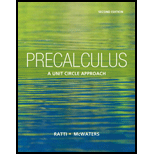
Precalculus: A Unit Circle Approach
2nd Edition
ISBN: 9780321825391
Author: Ratti
Publisher: PEARSON
expand_more
expand_more
format_list_bulleted
Concept explainers
Question
Chapter A.2, Problem 86E
To determine
Quotient and remainder of the given division problem using synthetic division.
Expert Solution & Answer
Want to see the full answer?
Check out a sample textbook solution
Students have asked these similar questions
question 10 please
00
(a) Starting with the geometric series Σ X^, find the sum of the series
n = 0
00
Σηχη - 1,
|x| < 1.
n = 1
(b) Find the sum of each of the following series.
00
Σnx",
n = 1
|x| < 1
(ii)
n = 1
sin
(c) Find the sum of each of the following series.
(i)
00
Σn(n-1)x^, |x| <1
n = 2
(ii)
00
n = 2
n²
- n
4n
(iii)
M8
n = 1
շո
(a) Use differentiation to find a power series representation for
1
f(x)
=
(4 + x)²*
f(x)
=
00
Σ
n = 0
What is the radius of convergence, R?
R =
(b) Use part (a) to find a power series for
f(x)
=
1
(4 + x)³°
f(x) =
00
Σ
n = 0
What is the radius of convergence, R?
R =
(c) Use part (b) to find a power series for
f(x)
=
x²
(4 + x)³*
00
f(x) = Σ
n = 2
What is the radius of convergence, R?
R =
Need Help? Read It
Watch It
SUBMIT ANSWER
Chapter A.2 Solutions
Precalculus: A Unit Circle Approach
Ch. A.2 - In Exercises 1-4, determine whether the given...Ch. A.2 - In Exercises 1-4, determine whether the given...Ch. A.2 - In Exercises 1-4, determine whether the given...Ch. A.2 - Prob. 4ECh. A.2 - In Exercises 5-8, find the degree and list the...Ch. A.2 - Prob. 6ECh. A.2 - Prob. 7ECh. A.2 - Prob. 8ECh. A.2 - In Exercises 9-16, perform the indicated...Ch. A.2 - In Exercises 9-16, perform the indicated...
Ch. A.2 - In Exercises 9-16, perform the indicated...Ch. A.2 - Prob. 12ECh. A.2 - Prob. 13ECh. A.2 - Prob. 14ECh. A.2 - Prob. 15ECh. A.2 - Prob. 16ECh. A.2 - Prob. 17ECh. A.2 - Prob. 18ECh. A.2 - Prob. 19ECh. A.2 - Prob. 20ECh. A.2 - Prob. 21ECh. A.2 - In Exercises 17-50, perform the indicated...Ch. A.2 - Prob. 23ECh. A.2 - Prob. 24ECh. A.2 - In Exercises 17-50, perform the indicated...Ch. A.2 - Prob. 26ECh. A.2 - Prob. 27ECh. A.2 - Prob. 28ECh. A.2 - Prob. 29ECh. A.2 - Prob. 30ECh. A.2 - Prob. 31ECh. A.2 - Prob. 32ECh. A.2 - Prob. 33ECh. A.2 - Prob. 34ECh. A.2 - Prob. 35ECh. A.2 - In Exercises 17-50, perform the indicated...Ch. A.2 - Prob. 37ECh. A.2 - Prob. 38ECh. A.2 - Prob. 39ECh. A.2 - In Exercises 17-50, perform the indicated...Ch. A.2 - Prob. 41ECh. A.2 - Prob. 42ECh. A.2 - In Exercises 17-50, perform the indicated...Ch. A.2 - In Exercises 17-50, perform the indicated...Ch. A.2 - In Exercises 17-50, perform the indicated...Ch. A.2 - Prob. 46ECh. A.2 - Prob. 47ECh. A.2 - Prob. 48ECh. A.2 - Prob. 49ECh. A.2 - Prob. 50ECh. A.2 - Prob. 51ECh. A.2 - Prob. 52ECh. A.2 - Prob. 53ECh. A.2 - Prob. 54ECh. A.2 - Prob. 55ECh. A.2 - Prob. 56ECh. A.2 - Prob. 57ECh. A.2 - Prob. 58ECh. A.2 - Prob. 59ECh. A.2 - Prob. 60ECh. A.2 - In Exercises 61-108, factor each polynomial...Ch. A.2 - In Exercises 61-108, factor each polynomial...Ch. A.2 - In Exercises 61-108, factor each polynomial...Ch. A.2 - In Exercises 61-108, factor each polynomial...Ch. A.2 - In Exercises 61-108, factor each polynomial...Ch. A.2 - Prob. 66ECh. A.2 - In Exercises 61-108, factor each polynomial...Ch. A.2 - Prob. 68ECh. A.2 - Prob. 69ECh. A.2 - Prob. 70ECh. A.2 - In Exercises 61-108, factor each polynomial...Ch. A.2 - In Exercises 61-108, factor each polynomial...Ch. A.2 - In Exercises 61-108, factor each polynomial...Ch. A.2 - In Exercises 61-108, factor each polynomial...Ch. A.2 - Prob. 75ECh. A.2 - In Exercises 61-108, factor each polynomial...Ch. A.2 - In Exercises 61-108, factor each polynomial...Ch. A.2 - In Exercises 61-108, factor each polynomial...Ch. A.2 - In Exercises 61-108, factor each polynomial...Ch. A.2 - In Exercises 61-108, factor each polynomial...Ch. A.2 - Prob. 81ECh. A.2 - Prob. 82ECh. A.2 - Prob. 83ECh. A.2 - Prob. 84ECh. A.2 - In Exercises 61-108, factor each polynomial...Ch. A.2 - Prob. 86ECh. A.2 - Prob. 87ECh. A.2 - In Exercises 61-108, factor each polynomial...Ch. A.2 - In Exercises 61-108, factor each polynomial...Ch. A.2 - In Exercises 61-108, factor each polynomial...Ch. A.2 - In Exercises 61-108, factor each polynomial...Ch. A.2 - In Exercises 61-108, factor each polynomial...Ch. A.2 - In Exercises 61-108, factor each polynomial...Ch. A.2 - Prob. 94ECh. A.2 - Prob. 95ECh. A.2 - Prob. 96ECh. A.2 - Prob. 97ECh. A.2 - Prob. 98ECh. A.2 - Prob. 99ECh. A.2 - Prob. 100ECh. A.2 - Prob. 101ECh. A.2 - Prob. 102ECh. A.2 - Prob. 103ECh. A.2 - Prob. 104ECh. A.2 - Prob. 105ECh. A.2 - Prob. 106ECh. A.2 - Prob. 107ECh. A.2 - Prob. 108ECh. A.2 - Prob. 109ECh. A.2 - Prob. 110ECh. A.2 - Prob. 111ECh. A.2 - Prob. 112ECh. A.2 - Prob. 113ECh. A.2 - In Exercises 61-108, factor each polynomial...Ch. A.2 - In Exercises 61-108, factor each polynomial...Ch. A.2 - Prob. 116ECh. A.2 - Prob. 117ECh. A.2 - Prob. 118ECh. A.2 - Prob. 119ECh. A.2 - Prob. 120ECh. A.2 - Prob. 121ECh. A.2 - In Exercises 61-108, factor each polynomial...Ch. A.2 - Prob. 123ECh. A.2 - Prob. 124ECh. A.2 - In Exercises 61-108, factor each polynomial...Ch. A.2 - Prob. 126ECh. A.2 - Prob. 127ECh. A.2 - Prob. 128ECh. A.2 - Prob. 129ECh. A.2 - Prob. 130ECh. A.2 - Prob. 131ECh. A.2 - Prob. 132ECh. A.2 - Prob. 133ECh. A.2 - Prob. 134ECh. A.2 - Prob. 135ECh. A.2 - Prob. 136ECh. A.2 - Prob. 137ECh. A.2 - Prob. 138ECh. A.2 - Prob. 139ECh. A.2 - Prob. 140ECh. A.2 - Prob. 141ECh. A.2 - Prob. 142ECh. A.2 - Prob. 143ECh. A.2 - Prob. 144E
Knowledge Booster
Learn more about
Need a deep-dive on the concept behind this application? Look no further. Learn more about this topic, calculus and related others by exploring similar questions and additional content below.Similar questions
- answer for question 4 pleasearrow_forward(3) (20 points) Let F(x, y, z) = (y, z, x²z). Define E = {(x, y, z) | x² + y² ≤ z ≤ 1, x ≤ 0}. (a) (2 points) Calculate the divergence V. F. (b) (4 points) Let D = {(x, y) | x² + y² ≤ 1, x ≤ 0} Without calculation, show that the triple integral √ (V · F) dV = √ 2²(1. = x²(1 − x² - y²) dA. Earrow_forward(2) (22 points) Let F(x, y, z) = (x sin y, cos y, ―xy). (a) (2 points) Calculate V. F. (b) (6 points) Given a vector field is everywhere defined with V G₁(x, y, z) = * G2(x, y, z) = − G3(x, y, z) = 0. 0 0 F(x, y, z) = (F₁(x, y, z), F₂(x, y, z), F(x, y, z)) that F = 0, let G = (G1, G2, G3) where F₂(x, y, y, t) dt - √ F³(x, t, 0) dt, * F1(x, y, t) dt, t) dt - √ F Calculate G for the vector field F(x, y, z) = (x sin y, cos y, -xy).arrow_forward
- Evaluate the following integral over the Region R. (Answer accurate to 2 decimal places). √ √(x + y) A R R = {(x, y) | 25 < x² + y² ≤ 36, x < 0} Hint: The integral and Region is defined in rectangular coordinates.arrow_forwardFind the volume of the solid that lies under the paraboloid z = 81 - x² - y² and within the cylinder (x − 1)² + y² = 1. A plot of an example of a similar solid is shown below. (Answer accurate to 2 decimal places). Volume using Double Integral Paraboloid & Cylinder -3 Hint: The integral and region is defined in polar coordinates.arrow_forwardEvaluate the following integral over the Region R. (Answer accurate to 2 decimal places). √4(1–2² 4(1 - x² - y²) dA R 3 R = {(r,0) | 0 ≤ r≤ 2,0π ≤0≤¼˜}. Hint: The integral is defined in rectangular coordinates. The Region is defined in polar coordinates.arrow_forward
- Evaluate the following integral over the Region R. (Answer accurate to 2 decimal places). R - 1 · {(r,0) | 1 ≤ r≤ 5,½π≤ 0<1π}. Hint: Be sure to convert to Polar coordinates. Use the correct differential for Polar Coordinates.arrow_forwardEvaluate the following integral over the Region R. (Answer accurate to 2 decimal places). √ √2(x+y) dA R R = {(x, y) | 4 < x² + y² < 25,0 < x} Hint: The integral and Region is defined in rectangular coordinates.arrow_forwardHW: The frame shown in the figure is pinned at A and C. Use moment distribution method, with and without modifications, to draw NFD, SFD, and BMD. B I I 40 kN/m A 3 m 4 marrow_forward
- Let the region R be the area enclosed by the function f(x)= = 3x² and g(x) = 4x. If the region R is the base of a solid such that each cross section perpendicular to the x-axis is an isosceles right triangle with a leg in the region R, find the volume of the solid. You may use a calculator and round to the nearest thousandth. y 11 10 9 00 8 7 9 5 4 3 2 1 -1 -1 x 1 2arrow_forwardLet the region R be the area enclosed by the function f(x) = ex — 1, the horizontal line y = -4 and the vertical lines x = 0 and x = 3. Find the volume of the solid generated when the region R is revolved about the line y = -4. You may use a calculator and round to the nearest thousandth. 20 15 10 5 y I I I | I + -1.5 -1 -0.5 0.5 1 1.5 2 2.5 3 -5 I -10 -15 I + I I T I I + -20 I + -25 I I I -30 I 3.5 4 xarrow_forwardplease show all the workarrow_forward
arrow_back_ios
SEE MORE QUESTIONS
arrow_forward_ios
Recommended textbooks for you
 Intermediate AlgebraAlgebraISBN:9781285195728Author:Jerome E. Kaufmann, Karen L. SchwittersPublisher:Cengage Learning
Intermediate AlgebraAlgebraISBN:9781285195728Author:Jerome E. Kaufmann, Karen L. SchwittersPublisher:Cengage Learning Algebra for College StudentsAlgebraISBN:9781285195780Author:Jerome E. Kaufmann, Karen L. SchwittersPublisher:Cengage Learning
Algebra for College StudentsAlgebraISBN:9781285195780Author:Jerome E. Kaufmann, Karen L. SchwittersPublisher:Cengage Learning College Algebra (MindTap Course List)AlgebraISBN:9781305652231Author:R. David Gustafson, Jeff HughesPublisher:Cengage Learning
College Algebra (MindTap Course List)AlgebraISBN:9781305652231Author:R. David Gustafson, Jeff HughesPublisher:Cengage Learning
 Elementary AlgebraAlgebraISBN:9780998625713Author:Lynn Marecek, MaryAnne Anthony-SmithPublisher:OpenStax - Rice University
Elementary AlgebraAlgebraISBN:9780998625713Author:Lynn Marecek, MaryAnne Anthony-SmithPublisher:OpenStax - Rice University Big Ideas Math A Bridge To Success Algebra 1: Stu...AlgebraISBN:9781680331141Author:HOUGHTON MIFFLIN HARCOURTPublisher:Houghton Mifflin Harcourt
Big Ideas Math A Bridge To Success Algebra 1: Stu...AlgebraISBN:9781680331141Author:HOUGHTON MIFFLIN HARCOURTPublisher:Houghton Mifflin Harcourt

Intermediate Algebra
Algebra
ISBN:9781285195728
Author:Jerome E. Kaufmann, Karen L. Schwitters
Publisher:Cengage Learning

Algebra for College Students
Algebra
ISBN:9781285195780
Author:Jerome E. Kaufmann, Karen L. Schwitters
Publisher:Cengage Learning

College Algebra (MindTap Course List)
Algebra
ISBN:9781305652231
Author:R. David Gustafson, Jeff Hughes
Publisher:Cengage Learning


Elementary Algebra
Algebra
ISBN:9780998625713
Author:Lynn Marecek, MaryAnne Anthony-Smith
Publisher:OpenStax - Rice University

Big Ideas Math A Bridge To Success Algebra 1: Stu...
Algebra
ISBN:9781680331141
Author:HOUGHTON MIFFLIN HARCOURT
Publisher:Houghton Mifflin Harcourt
Polynomials with Trigonometric Solutions (2 of 3: Substitute & solve); Author: Eddie Woo;https://www.youtube.com/watch?v=EnfhYp4o20w;License: Standard YouTube License, CC-BY
Quick Revision of Polynomials | Tricks to Solve Polynomials in Algebra | Maths Tricks | Letstute; Author: Let'stute;https://www.youtube.com/watch?v=YmDnGcol-gs;License: Standard YouTube License, CC-BY
Introduction to Polynomials; Author: Professor Dave Explains;https://www.youtube.com/watch?v=nPPNgin7W7Y;License: Standard Youtube License